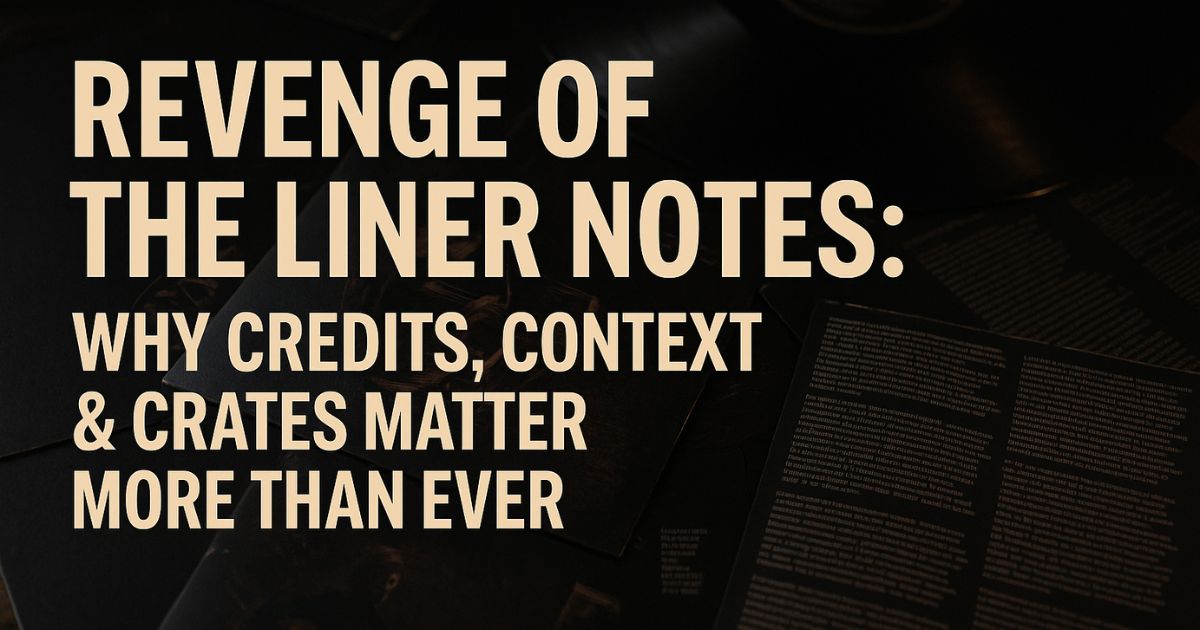Physical Address
5106 Whitman Way, Carlsbad, CA 92008
Physical Address
5106 Whitman Way, Carlsbad, CA 92008

As streaming strips music of its stories, liner notes—once afterthoughts—are re-emerging as essential tools for discovery, memory, and meaning. From crate-digging DJs to metadata obsessives and nostalgic fans, this piece explores how liner notes, credits, and tangible context are reclaiming their cultural power in 2025.
Once printed on wax sleeves, CD booklets, and cassette j-cards, liner notes were a tactile gateway to music’s soul—a blend of credits, essays, shout-outs, backstories, and photos. Then came digital. Napster. iTunes. Spotify. Metadata got minimized. Music felt disembodied.
But that’s changing. In 2025, we’re seeing a grassroots liner note renaissance, driven by artists, fans, and platforms who are hungry for music with context.
“A name in the credits can unlock a whole universe,” says archival crate-digger and producer Adrian Younge. “Every sample has a source. Every sound has a lineage.”
Behind every track lies a community. Writers, engineers, mixers, session players, sample sources, graphic designers, cultural movements. When liner notes vanish, so does the map to that community.
Check out our breakdown of how digital service providers can help independents reclaim this value.
What crate-digging was to vinyl, “metadigging” is to the streaming age.
Platforms like Discogs, WhoSampled, and even TikTok subcultures are driving this revival—helping users go deeper, not just faster.
🎧 Try it: Go listen to a classic like D’Angelo’s Voodoo. Then explore every musician credited. You’ll end up with a playlist 12 hours long and a whole new appreciation for Questlove’s snare work.
For more metadata-rich exploration, visit our article on music discovery rituals that still work.
Today’s liner notes live in unexpected places:
Even digital albums are embracing long-form storytelling. Just look at the deluxe editions of Kendrick Lamar or Mitski projects—complete with essays, zines, and photo diaries.
Looking to share your own liner notes? Start with our music submission guide.
Spotify recently expanded songwriter and producer credits (though it’s buried in a submenu). Apple Music is building classical metadata frameworks. Even vinyl is back, in part because it gives music its story back.
But the real movement is grassroots.
Explore how metadata and credits play a role in music analytics and AI discovery, or dive into the future of indie pop with our article: The Future of Indie Pop: 2025 Trends & Playlist
Whether it’s physical vinyl bins or digital archives, crate digging is a ritual of reverence. You’re not just looking for songs—you’re looking for stories. For names. For connections.
Want to dig deeper? These stories complement the culture of liner notes and discovery:
In a world of 15-second clips and infinite scroll, the liner note isn’t a relic. It’s a resistance.
It’s a way to say: This matters. These people mattered. This music didn’t appear from nowhere.
So whether you’re a vinyl hunter, Spotify sleuth, or digital diarist—start reading the notes again. Better yet, start writing them.
Looking for more editorial depth on NewMusicWorld.org? Here are a few fan-favorite pieces: